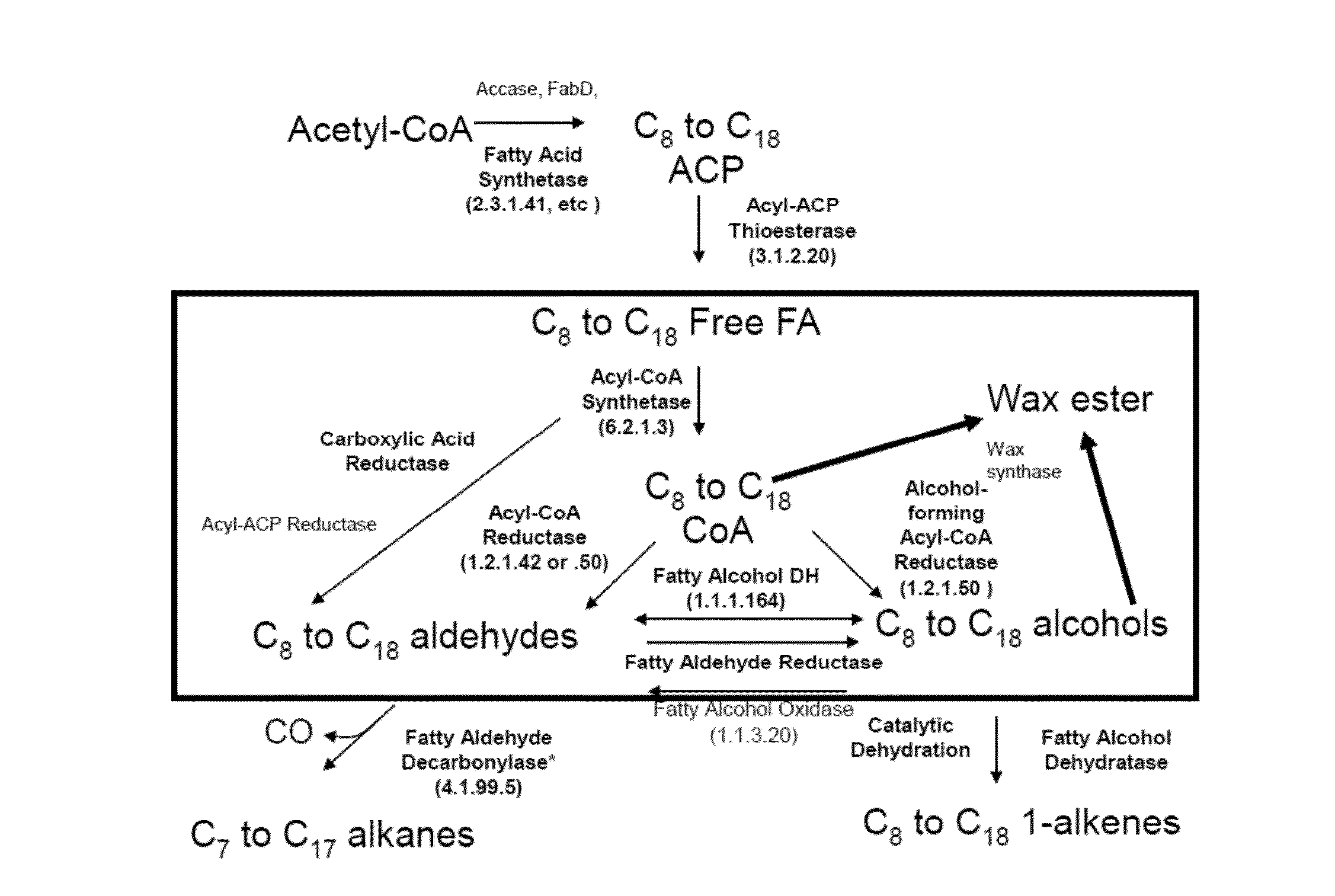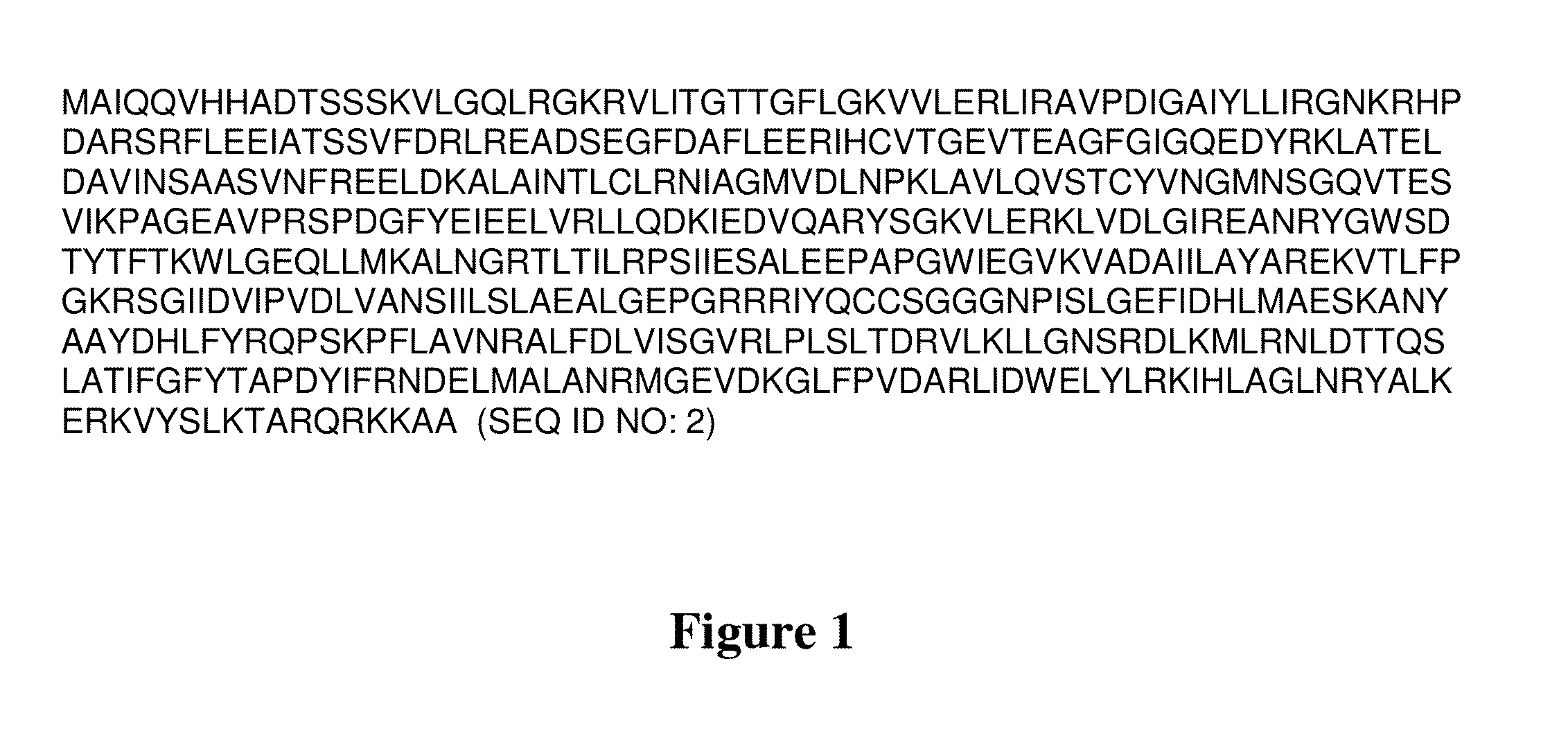Acyl-acp wax ester synthases
a technology of acyl-acp wax ester and acyl-acp, which is applied in the fields of metabolic biochemistry, bioengineering, molecular biology, etc., can solve the problems of cellular membranes, finite resources, and fossil fuel depletion
- Summary
- Abstract
- Description
- Claims
- Application Information
AI Technical Summary
Benefits of technology
Problems solved by technology
Method used
Image
Examples
embodiments
Embodiment 1
[0264]A recombinant host cell genetically engineered for the production of fatty acid esters, wherein the recombinant host cell comprises a non-native nucleic acid sequence that encodes a wax ester synthase capable of producing a fatty acid ester in an acyl-CoA-independent pathway upon expression in the host cell, wherein the recombinant host cell does not include an exogenous nucleic acid molecule encoding an acyl-ACP thioesterase, an exogenous nucleic acid molecule encoding an acyl-CoA thioesterase, and / or an exogenous nucleic acid molecule encoding an acyl-CoA synthetase, and optionally does nto include any of the above-listed exogenous nucleic acid molecules.
embodiment 2
[0265]The recombinant host cell according to embodiment 1, wherein the wax ester synthase is capable of using acyl-ACP as a substrate, further wherein the wax ester synthase comprises a polypeptide that has sequence identity of at least 40%, 45%, 50%, 55%, 60%, 65%, 70%, 75%, 80%, 85%, 86%, 87%, 88%, 89%, 90%, 91%, 92%, 93%, 94%, 95%, 96%, 97%, 98%, 99%, or 100% to the polypeptide of SEQ ID NO: 19, 21, 23, 25, 27, 29, 31, 33, 35, 37, 39, 41, or 43, or to a functional fragment of the polypeptide of SEQ ID NO: 19, 21, 23, 25, 27, 29, 31, 33, 35, 37, 39, 41, or 43.
embodiment 3
[0266]A recombinant host cell genetically engineered for the production of wax esters, wherein the recombinant host cell comprises:
[0267]a non-native nucleic acid sequence that encodes an acyl-ACP wax ester synthase, optionally wherein the acyl-ACP wax ester synthase that has sequence identity of at least 40%, 45%, 50%, 55%, 60%, 65%, 70%, 75%, 80%, 85%, 86%, 87%, 88%, 89%, 90%, 91%, 92%, 93%, 94%, 95%, 96%, 97%, 98%, 99%, or 100% to the polypeptide of SEQ ID NO: 19, 21, 23, 25, 27, 29, 31, 33, 35, 37, 39, 41, or 43, or to a functional fragment of the polypeptide encoded by any of SEQ ID NO: 19, 21, 23, 25, 27, 29, 31, 33, 35, 37, 39, 41, or 43, and
[0268]a non-native nucleic acid sequence that encodes an alcohol-forming acyl-ACP reductase, optionally wherein the alcohol-forming acyl-ACP reductase comprises a polypeptide that has sequence identity of at least 40%, 45%, 50%, 55%, 60%, 65%, 70%, 75%, 80%, 85%, 86%, 87%, 88%, 89%, 90%, 91%, 92%, 93%, 94%, 95%, 96%, 97%, 98%, 99%, or 100...
PUM
 Login to View More
Login to View More Abstract
Description
Claims
Application Information
 Login to View More
Login to View More - R&D Engineer
- R&D Manager
- IP Professional
- Industry Leading Data Capabilities
- Powerful AI technology
- Patent DNA Extraction
Browse by: Latest US Patents, China's latest patents, Technical Efficacy Thesaurus, Application Domain, Technology Topic, Popular Technical Reports.
© 2024 PatSnap. All rights reserved.Legal|Privacy policy|Modern Slavery Act Transparency Statement|Sitemap|About US| Contact US: help@patsnap.com










